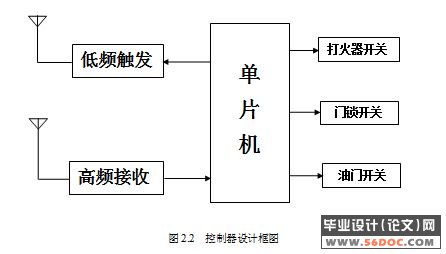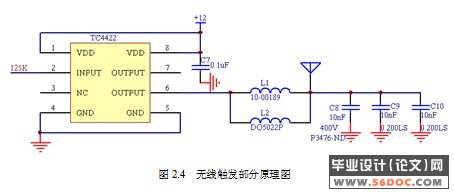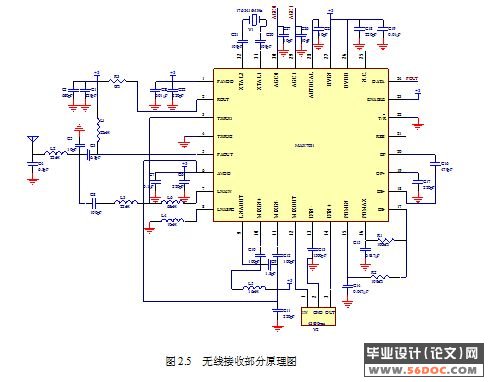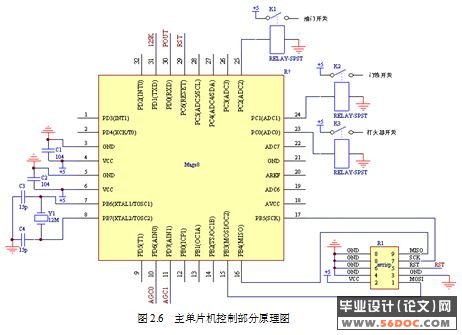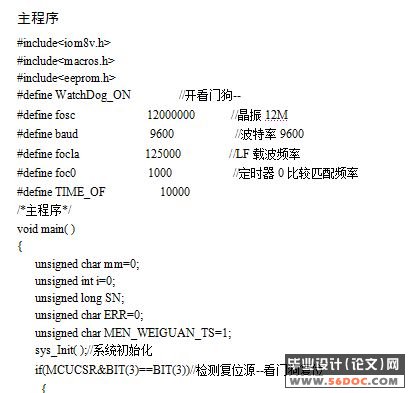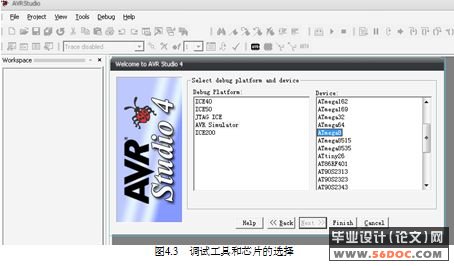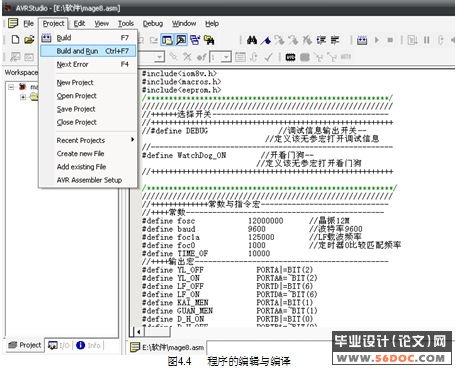摘 要
本文讲述了新型汽车智能门锁控制器的设计与实现。主要是对现有的汽车智能门锁控制器进行了新的设计,可以无需使用按钮,自动识别遥控器的位置,根据它的位置来确定门锁、打火器、油门的开关,更适应现代社会更多人的需求。门锁控制器分为车内控制器和手中的遥控器(电子钥匙),本论文主要是对车内的控制器的设计。该控制器选用单片机为核心部件来控制,通过输出的高低频来控制门锁、油门、打火器的开关。这些动作是通过与电子钥匙之间的通信决定的,所以还有低频触发部分和高频接收部分与主单片机一起来完成整项功能。本系统选用C语言来进行软件设计,C语言既有高级语言的特点,又具有汇编语言的特点。它可以作为系统设计语言,编写工作系统应用程序,也可以作为应用程序设计语言,编写不依赖计算机硬件的应用程序。
首先在绪论中介绍了此系统的开发背景、意义、系统功能及设计方法。
此后,本文在第二章描述了系统硬件设计过程,确定了器件的选择,论述了系统硬件电路设计、硬件设计结构框图,并对所使用各种芯片的功能与特性进行了详细介绍。
在第三章中重点剖析了软件设计开发的过程,尤其是主程序、系统初始化子程序和无线收发子程序的工作流程,软件语言。
最后在第四章中具体介绍了编译环境,并描述了在此环境下程序的编辑和编译过程。
关键词:单片机;门锁控制器;无线收发;C语言;高频;低频
Door lock controller of smart car
Abstract
This article introduces the design and implementation of door lock controller of new smart car. The importance is the new design of the lock controller of original smart car door, it can recognize where the electronic key is without button, even to adapt to the social people’s needs. The door lock controller is composed of the car controller and the remote controller of hand (electronic keys), the design’s leitmotiv is the design of the controller of the car. The controller choose microcontroller as the core components to control, through the high low frequency output to control the switch of the door lock, the accelerator and the firearm. These are designed with the wireless communications between the electronic key and the door lock controller, so, there are some low frequency transmits and high frequency receiver and the main part of the microcontroller to complete the function. The system choose C language to complete software, the C language not only has advanced language features, but also has the characteristics of assembly language. It can be used as system designing language, preparation of system applications, can also be used as application programming language, also it dose not rely on computer hardware to prepare the application.
The first chapter introduces the background of this system, meaning, function and design methods.
Since then, the paper dissertate the design process of hardware in the second chapter, determine the device's choice on the system hardware circuit design, hardware design and structure diagram of the chips are used by various functions and characteristics described in detail in chapter 3 analysis of key software design and development process, particularly the main program, the system initialization subroutine and wireless transceiver subroutine workflow.
Finally, the paper introduces materially the specific compiler environment in chapter four, and describes the environment in this process of editing and compiling process.
Key Words:write criterion;door lock controller; wireless transceiver;C language;high frequency; low frequency
设计内容及要求 设计一种新型汽车智能门锁控制器,在现有门锁控制器功能的基础上取消按钮,利用无线通信搜索遥控器来进行控制,为那些常常因为忘记是否锁车门而烦恼的压力大和老年人群带来方便。
控制器要与遥控器进行无线通信,所以控制器既有发送又有接收功能。控制器是主体部分,所以要掌握主导功能,首先是要完成对遥控器的低频触发,接下来接收来自遥控器的高频信号,根据是否收到信号或者信号是否匹配来决定对门锁、油门、打火器的开关动作。
课题完成的功能
(1) 继承现有的门锁控制器功能,即使用控制器与电子钥匙通讯来控制。
(2) 在现有的门锁控制器的的基础上做如下设计:
取消按钮这个步骤,但不是将现有的按钮功能全部全部取消,只是改为自动控制,控制器可以自动识别遥控器的位置,不需要车主每次都按按钮。具体控制方式是;车主关门并距车两米的时候车门自动上锁,相应的打火器、油门也关闭,这样就避免了车主忘记自己是否按按钮锁门这种情况的发生。在车主带着钥匙进入距离车两米的范围,控制器与遥控产生感应,车门自动开锁。毫无疑问,车锁就是一个遥控器,来控制车内的控制器。控制器定时低频触发遥控器,遥控器高频回复控制器,即采用编码无线发射和无线接收译码方式。
目 录 19000字
摘 要 I
Abstract II
引 言 1
1 绪论 2
1.1 课题的开发背景 2
1.2 课题设计的意义 3
1.3 课题完成的功能 4
1.4 课题的设计方法 4
2 电路设计 6
2.1 电路原理框图 6
2.1.1 总体框图 6
2.1.2 控制器框图 6
2.2 电路组成原理图 8
2.3 无线触发部分原理图 8
2.3.1 无线触发模块频率及芯片选择 8
2.3.2 无线触发模块的原理图 9
2.4 无线接收部分原理图 10
2.4.1 无线接收模块频率及芯片选择 10
2.4.2 无线接收模块原理图 11
2.5 单片机电路原理图 12
2.5.1 单片机型号的选择及描述 12
2.5.2 单片机电路原理图 15
2.5.3 电路设计总框图.13
3 程序设计 18
3.1 通信协议设定 18
3.1.1 数据格式和波特率 18
3.1.2 通信协议 19
3.1.3 程序流程图17
3.2 编程思想 22
3.3 主程序 22
3.4 子程序 24
3.4.1 初始化程序 24
3.4.2 控制器无线发送子程序 27
3.4.3 控制器无线接收子程序.26
4 编译环境介绍 34
结 论 37
参 考 文 献 38
附录 程序代码 39
致 谢 45
|

